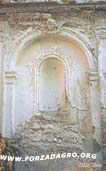The Church of St. Anthony the Abbott |
|
|
Right at the end of the long and narrow main road of Forza d'Agrò, in an area now slightly raised above street level, stands the Church of St. Anthony, the small adjacent square and the entire quarter are named after the church. It probably dates back to the end of the 16th century. The church is of a simple structure and is positioned sideways at the top of a brief flight of steps. The facade faces south-east-east and is reinforced laterally by pilasters, from the top rises a small and simple bell tower. The whole aspect is embellished by a beautiful portal and sandstone lintel with fanciful motifs in relief, such as the typical winged cherub in the middle of the lintel. On the upper, arched part of the portal is a bas-relief of two vases with pedestals and spirals, one on each side, and a central crest. Unfortunately, weathering over the years has caused a progressive crumbling of the sandstone. There is a window in the middle of the facade, between the roof and the door. The rather small interior consists of one nave and is startling for the absolute whiteness of its walls that brightens the entire setting. On the internal part of the facade, just above the door, a crest is still visible in white stucco with borders in curvilinear relief, the dedication of the church was probably once located here. Picture frames are in relief and bordered by curvilinear motifs and spirals, always in white stucco, as is characteristic of the churches in Forza d'Agrò of this period. The walls are adorned by seven altars, three on the right, three on the left, and the main altar originally placed near the apse that no longer exists but of which still remain traces of the finely decorated arch of triumph. The altars, separated by false pillars (pilasters), are surrounded by arches crowned by the typical little winged heads of cherubs and once housed the sacred images of St. Lucy, Our Lady of Sorrows, St. Sebastian, the Madonna of Carmel, St. Anthony the Abbot, St. Philip and St. Anthony of Padua. There are also picture frames at the ends of the lateral walls and on the internal part of the facade. The floor is made of hexagonal red tiles.
Today, little remains of the old church. After the appearance of the first signs of damage and the fear of possible collapse, the destruction of the wall behind the main altar was advised. Whereas a violent wind at the beginning of the 1970’s caused the collapse of the roof. However, since the 1950’s the church had not been used for religious ceremonies. In the first months of 1999, a restoration that prevented further degradation of the religious building was completed. The sloping roof was rebuilt, the structure reinforced and the altars restored. Some valuable paintings dating from the end of the 16th century were once to be found in this church. In particular, as well as the statues of St. Philip and St. Lucy, were a painting representing the same St. Lucy and another, positioned on the main altar, of the Madonna of Carmel (a Matri ‘u Carminu, in the local dialect). In the area around and below the church dedicated to St. Anthony the Abbot extends the Rocca quarter, with its houses rising from or leaning against the large boulders of the region arranged on cliffs sloping down towards the countryside with distant views of the Agrò River, the surrounding hills and the Ionian sea. |
|
|
Translation by
Connie Badolato
|
|
|
|
|
|
|
Forzadagro.org 2001-2017 |
|
|


